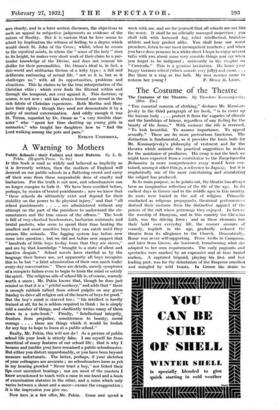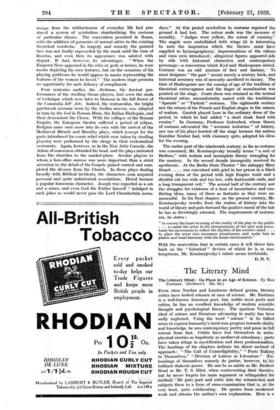The Costume of the Theatre
The Costume of the Theatre. By Theodore Komisarjevsky. (Bios. 25s.) " Tun essential concern of clothing," declares Mr. Komisar- jevsky in the third paragraph of his book, " is to cover up the human body . . . . protect it from the vagaries of climate and the hardships of labour, regardless of any feeling for the beauty of the forms." With costume the role is reversed. " To look beautiful. To assume importance. To appeal sexually." These are its more pretentious functions. The distinction is fundamental, as it provides the basis both for Mr. Komisarjevsky's philosophy of vestment and for the theories which animate the practical suggestions he makes for the assistance of producers. His essay is not the book we might have expected from a contributor to the Encyclopaedia Briiannica (a more comprehensive essay would have con- tained, amongst other things, a reference to Japan); but it is emphatically one of the most entertaining and stimulating the subject has produced.
In its main purpose, as he points out, the theatre has always been an imaginative reflection of the life of the age. In its earliest days in Greece and in the middle ages in this country its roots were buried in the soil of religion. Primarily conducted as religious propaganda, theatrical performances derived their costume from the distinctive apparel of the priests of the cult whose patronage they enjoyed. In Grscee the worship of Dionysus, and in this country the Christian faith, was the driving force ; and as these elements lost their hold over everyday life, the coarser savours of comedy, implicit in the age, gradually seduced the theatre from its allegiance to the Church. Dramatically, Rome was never self-supporting. From Atella in Campania, and later from Greece, she borrowed, transforming what she adopted to her own requirements. The early pageants and spectacles were marked by an expensive and at time brutal realism. A captured brigand, playing his first and last leading part, was for the delectation of the Emperor crucified and mangled by wild beasts. In Greece the desire to escape from the utilitarianism of everyday life had pro- duced a system of symbolism standardizing the costume of particular classes. The convention persisted in Rome, with the addition Of garments of normal attire to the existing theatrical wardrobe. In tragedy and comedy the painted face was not finally superseded by the mask until the time of Hoscius, and even then its appearance was saluted with disgust. It had, however, its advantages. " When the Emperor Nero appeared in the roles of gods or heroes, he wore masks depicting his own features, but on the occasions of hii playing goddesses he would appear in masks representing the features of the women he loved." The modern stage presents no opportunity for such delicacy of compliment.
Four centuries earlier, the Atellanae, the farcical per- formances of the strolling Oscan players, had sown the seeds of technique which were later to bloSsom in the full flower Of the Commedia dell' Ark. Indeed, the centuneulus, the bright patchwork costume worn by the Atellan mamas, was adopted in turn by the fool in Roman Mime, the Italian Harlequin, and their descendant the Clown. With the collapse of the Roman Empire, the European theatre suffered a period of eclipse. Religion came once more into its own with the arrival of the Mediaeval Miracle and Morality plays, Which (except for the parts introduced for comic relief which were taken by strolling players) were performed by the clergy in their ecclesiastical vestments. Again, however, as in the New Attic Comedy, the Adam of coarseness obtruded his head, and the plays retreated from the churches to the market-place. Secular players to whom a box-office success was more important than a strict attention to the detail of the Gospels gained control and com- pleted the divorce from the Church. In these plays dealing broadly with Biblical incidents, the characters soon acquired personal and quite unhistorical associations. Herod became a popular humorous character. Joseph was regarded as a sot and a miser, and even God the Father himself " indulged in such jokes as would never pass the Lord Chamberlain nowa- days." At this period symbolism in costume regained the ground it had lost. The colour scale was the measure of morality. " Judges wore yellow, the colour of cunning." The angels were embellished with wings- (it is interesting to note the inspiration which the theatre must have supplied to hymnographers); impersonations of the virtues and vices were introduced ; allegorical figures appeared side by side with historical characters and contemporary personage—a convention which Kyd and Shakespeare served. Costume was an odd mixture of fact and fantasy. To most designers " the past " meant merely a century back, and historical accuracy was of necessity sacrificed to luxury. :The time of Shakespeare saw the coming of age of the tradition of theatrical extravagance and the finger of moralization was pointed at the stage. Court dress was retained as the normal theatrical attire, uncomfortably mated with the traditional "Spanish" or " Turkish " costume. The eighteenth century saw the return of the French and English stages to the canons of realism. Garrick played Lear' in the ordinary dress of the period, to which he had added " a short cloak lined with ermine." In Germany, Professor Gottsehed, whose theory of costume advocated the " accurate imitation " of history, saw one of his plays howled off the stage because the actress Karoline Neuber bad, with visionary spite, adopted his ideas for the evening.
The earlier part of the nineteenth century, so far as costume was concerned, Mr. Komisarjevsky broadly terms " a sort of Bedlam," with realism and incomplete theory wrangling for the mastery. In the second decade incongruity received its apotheosis. At the Berlin State,Theatre " the'unhappy Mary Stuart . . . . was convulsed with grief in her prison in a black evening dress of the period with high Empire waist and a décolleté cut too wide and too low, with fashionable curls, and a long transparent veil." The second half of the century saw the struggles for existence of a host of inconclusive and con- flicting ideas, many of them as fantastic as they were un- successful. In his final chapter, on the present century, Mr. Komisarjevsky recedes from the realms of history into the world of theory and puts forward the positive moral of the tale he has so divertingly adorned. The requirements of costume are, he states : " to convey the inner maaning of the reality of the play to the public . . . to assist the actor in his interpretation of the part and accen- tuate his movements to reflect the rhythm of his creative mind . . . to place the actor into necessary prominence, and make him in plastic and tonal harmony with his scenic environment."
With the reservation that in certain cases it will throw him back on the " historical " deVices of which he is so con- temptuous, Mr. Komisarjevsky's rubric seems irrefutable.
D. H. V.



































 Previous page
Previous page